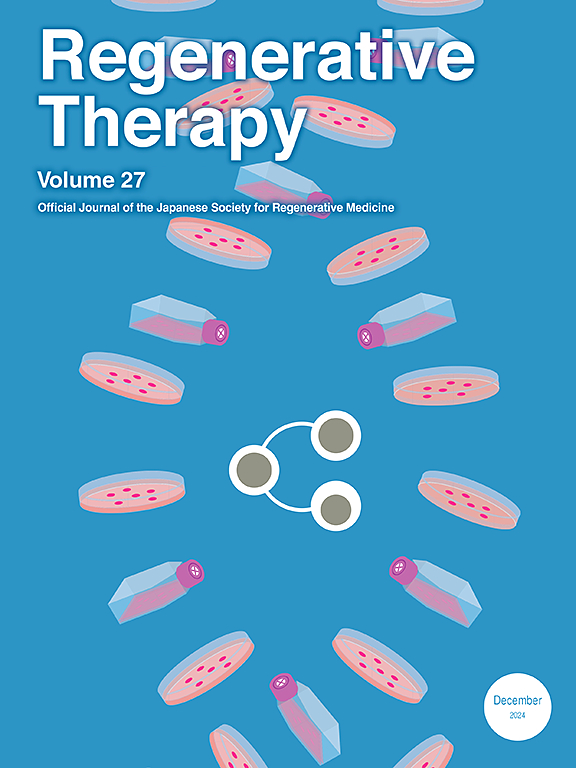控制黑素细胞密度的可重复性培养表皮片生产方法的建立
IF 3.5
3区 环境科学与生态学
Q3 CELL & TISSUE ENGINEERING
引用次数: 0
摘要
白癜风是人类最常见的色素紊乱疾病,通过其深刻的心理和社会后果显著影响患者的生活质量。这种疾病的复杂发病机制和对患者健康的重大影响强调了对先进治疗方法的迫切需要。自体培养表皮移植治疗白癜风已经发展起来,这种治疗的疗效已经确定。然而,由于难以调节黑素细胞含量,术后受影响区域的色素沉着可能会出现差异。本研究旨在开发一种可重复的方法来制造含有黑色素细胞的培养表皮片,用于临床应用。方法在不同培养条件下制备人表皮角质形成细胞和黑色素细胞,测定角质形成细胞和黑色素细胞的增殖情况。采用DOPA染色和流式细胞术检测培养的表皮片中黑色素细胞的密度和百分比。此外,开发了一种具有特定补充剂的新型临床级黑素细胞培养基,避免了含有未知动物源性未知材料的牛垂体提取物。结果先播种黑素细胞比同时播种黑素细胞和角化细胞密度高。本研究制备高黑素细胞密度表皮片的最佳条件是第1天以1.0 × 104个细胞/cm2的速度播种黑素细胞,第2天以饲养细胞的速度播种,第3天以8.0 × 104个细胞/cm2的速度培养角质形成细胞。确定最佳的黑素细胞培养基为添加10 nM aMSH、10 nM内皮素-1和10 μg/mL FGF-2的培养基。结论本研究结果为开发有效的白癜风细胞疗法奠定了基础。本文章由计算机程序翻译,如有差异,请以英文原文为准。
Establishment of reproducible method for production of cultured epidermal sheets with controlled melanocyte density
Introduction
Vitiligo, the most common human pigmentary disorder, significantly impacts patients' quality of life through its profound psychological and social consequences. The condition's complex pathogenesis and substantial effect on patients' well-being underscore the critical need for advanced therapeutic approaches. Treatment for vitiligo by autologous cultured epidermal transplantation has been developed, and the efficacy of this treatment has been determined. However, there is concern that differences in postoperative pigmentation of affected areas may occur due to difficulty in adjusting melanocyte content. This study aimed to develop a reproducible method for fabricating cultured epidermal sheets containing melanocytes for use in clinical applications.
Methods
Human epidermal keratinocytes and melanocytes derived from skin tissues of volunteer donors were prepared under different culture conditions and the proliferation of keratinocytes and melanocytes was determined. The density and percentage of melanocytes in cultured epidermal sheets were evaluated by DOPA staining and flow cytometry. Moreover, a novel clinical-grade melanocyte culture medium with specific supplements was developed that avoids bovine pituitary extract containing unknown animal-derived unknown materials.
Results
The density of melanocytes was higher when melanocytes were seeded first, as opposed to the simultaneous seeding of melanocytes and keratinocytes. The best condition in the present study for preparing cultured epidermal sheets with high melanocyte density was to seed melanocytes at 1.0 × 104 cells/cm2 on Day 1, followed by feeder cells on Day 2 and keratinocytes at 8.0 × 104 cells/cm2 on Day 3. The optimal culture medium for melanocytes was determined to contain 10 nM aMSH, 10 nM endothelin-1, and 10 μg/mL FGF-2 as culture supplements.
Conclusions
The results of this study establish a foundation for the development of cell therapy effective for vitiligo.
求助全文
通过发布文献求助,成功后即可免费获取论文全文。
去求助
来源期刊

Regenerative Therapy
Engineering-Biomedical Engineering
CiteScore
6.00
自引率
2.30%
发文量
106
审稿时长
49 days
期刊介绍:
Regenerative Therapy is the official peer-reviewed online journal of the Japanese Society for Regenerative Medicine.
Regenerative Therapy is a multidisciplinary journal that publishes original articles and reviews of basic research, clinical translation, industrial development, and regulatory issues focusing on stem cell biology, tissue engineering, and regenerative medicine.
 求助内容:
求助内容: 应助结果提醒方式:
应助结果提醒方式:


